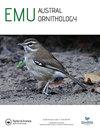Behavioural differences between ornamented and unornamented male Red-backed Fairywrens (Malurus melanocephalus) in the nonbreeding season
IF 1.1
4区 生物学
Q3 ORNITHOLOGY
引用次数: 0
Abstract
ABSTRACT During the breeding season, male Red-backed Fairywrens (Malurus melanocephalus) can exhibit ornamented (red-black) or unornamented (brown, resembling females and juveniles) plumage. These distinct plumage types represent alternative reproductive tactics and are associated with behavioural differences during the breeding season. However, we lack an understanding of whether and how these plumage types may be associated with behavioural differences during non-reproductive parts of the year. To fill this knowledge gap, we carried out behavioural observations during the nonbreeding season across three years. We hypothesised that ornamented plumage remains associated with mate attraction behaviours outside of the breeding season. We examined the investment of ornamented, moulting, and unornamented males in social behaviours and found that the three plumage types were largely similar in their behaviour except ornamented males courted and, to a lesser extent, allopreened at higher rates than unornamented males. Since concurrent work in the same study population demonstrates increased extra-pair fitness for males who moult into ornamented plumage early, we speculate that ornamentation and courtship behaviour may serve a mate attraction function outside of the breeding season. We argue that future studies should consider individual-level behavioural monitoring throughout the annual cycle to better quantify the complex selection pressures that lead to the coevolution of plumage moult and alternative reproductive tactics in this system.非繁殖期雄性红背鹪鹩(Malurus melanocephalus)的行为差异
在繁殖季节,雄性红背细尾鹩莺(Malurus melanocephalus)的羽毛可以有装饰(红黑色)或无装饰(棕色,类似于雌性和幼鸟)。这些不同的羽毛类型代表了不同的繁殖策略,并与繁殖季节的行为差异有关。然而,我们对这些羽毛类型是否以及如何与一年中非繁殖期的行为差异相关联缺乏了解。为了填补这一知识空白,我们在三年的非繁殖期进行了行为观察。我们假设,在繁殖季节之外,羽毛的装饰仍然与吸引配偶的行为有关。我们研究了有装饰的、换羽的和没有装饰的雄性在社会行为上的投入,发现除了有装饰的雄性比没有装饰的雄性更容易求爱,在较小程度上,这三种羽毛类型在行为上基本上是相似的。由于在同一研究群体中同时进行的工作表明,较早换出装饰羽毛的雄性增加了额外的配对适合度,我们推测装饰和求爱行为可能在繁殖季节之外起到吸引配偶的作用。我们认为,未来的研究应该考虑在整个年度周期中对个体层面的行为进行监测,以更好地量化导致羽毛换羽和该系统中其他生殖策略共同进化的复杂选择压力。
本文章由计算机程序翻译,如有差异,请以英文原文为准。
求助全文
约1分钟内获得全文
求助全文
来源期刊

Emu-Austral Ornithology
生物-鸟类学
CiteScore
2.00
自引率
7.70%
发文量
33
审稿时长
>12 weeks
期刊介绍:
Emu – Austral Ornithology is the premier journal for ornithological research and reviews related to the Southern Hemisphere and adjacent tropics. The journal has a long and proud tradition of publishing articles on many aspects of the biology of birds, particularly their conservation and management.
 求助内容:
求助内容: 应助结果提醒方式:
应助结果提醒方式:


